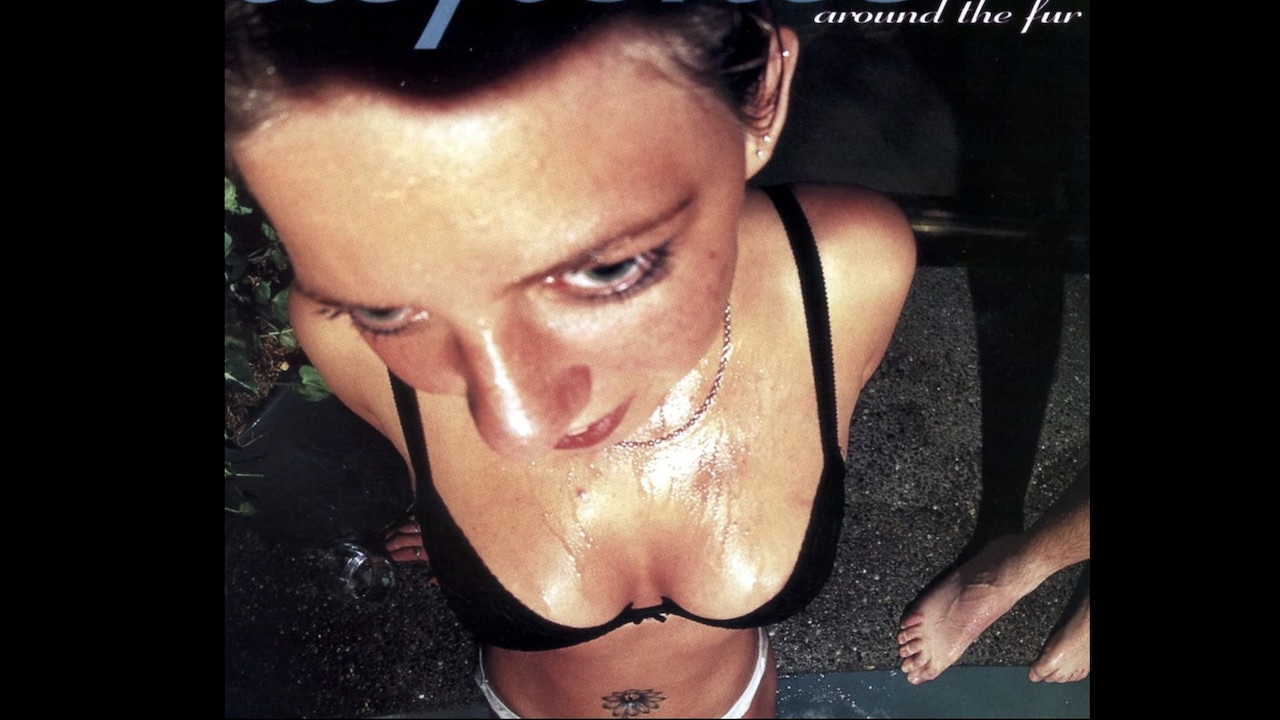Back in the mid 90’s the sound of nu-metal was certainly well known: the success of Korn, who were unquestionably the most hyped new band in heavy music, had seen to that. The name nu-metal though? Not so much. This new form of metal was a nameless, amorphic blob where anything that felt alternative and removed from the sound and aesthetic of classic heavy metal was lumped in together.
Korn, therefore, were viewed as being seated alongside Machine Head, Type O Negative, Helmet, Fear Factory, Biohazard and Sepultura in the realm of new (but not nu) metal. It was an exciting time; genre conventions be damned, it seemed to say, here are a bunch of bands that may not sound alike, but they’re all cool and distinctive in their own way.
And this was the perfect climate for a band as unique as Deftones to make their mark. The Sacramento quartet released their debut album Adrenaline on Madonna’s Maverick label in 1995, and almost immediately became one of the coolest names for metal fans to drop into conversation.
Adrenaline was a great debut, showcasing vocalist Chino Moreno’s whispered, slurred croon to scream style that felt utterly his alone, some fantastic use of dynamics, and influences refreshingly pulled from goth, indie, hip-hop and groove metal. They didn’t look like a metal band, they didn’t talk like one, but they were undeniably heavy and singular in sound.
In 1995 it would have felt pretty unique, but by 1997 the emergence of debut albums from Coal Chamber, Limp Bizkit, Incubus, Sevendust, Snot and (Hed)PE meant that the boundary-free musical style was becoming codified, displaying tropes, rules, and a signature sound. Nu-metal may have been in its infancy, but already, the best in the genre could see the walls closing in. One album in, having never wanted to be part of the scene in the first place, Deftones decided to make their escape from nu-metal.
This was the mindset that drove them to creating their breakthrough masterpiece; Around the Fur.
In mid-1997 Metal Hammer visited Studio Litho in Seattle where the band were working on their second album with producer Terry Date, finding them in confrontational mood.
“It’s something I say in one of the songs, ‘The separation starts here',” said Chino Moreno, referring to what would become Dai the Flu. “We separate ourselves from bullshit, from stupid ass fucking bands. Our last record, people love it, but I just think it’s okay.”
To help change their sound further Deftones embraced the most ethereal and cerebral elements of their influences, with Moreno pointing to bands like Depeche Mode as an inspiration rather than any metal artist. To assist this, the band made a key decision that helped to really shape their future by bringing in Frank Delgado on keys and turntables. DJs in metal bands were already proving to be exhaustingly ubiquitous, but Delgado, who would join as a full-time member in 1999, would prove that he was more than just another bloke occasionally scratching over chuggy seven string riffs. His contribution was subtle, but essential, adding depth, space and layers to the songs the band were writing.
“I think there’s more emotion on this one,” guitarist Stephen Carpenter told Hammer. “To me, the music sounds more passionate.”
There was one more contributor to the album who really upped the anticipation for Around the Fur; former Sepultura frontman Max Cavalera. In late 1996 Cavalera had acrimoniously parted ways with the band he formed in Brazil in 1984. Thanks to the success of Roots, Sepultura were, at the time, one of the biggest names in metal, but quickly became a soap opera, with finger-pointing and accusations about who was to blame for the split played out in the music press.
That though, wasn’t even close to being the worst thing to happen to Max Cavalera that year, with the news of his stepson Dana Well’s death coming on the eve of Sepultura’s biggest ever show at the Monsters of Rock festival at Donington Park that summer.
Moreno was close to Wells, and it was his intention to write a song in tribute to his late friend on Around the Fur.
“It’s a crazy ass song,” Moreno told Hammer of Headup. “We all sat around and wrote in the studio and jammed some stuff. I think we’re going to dedicate the record to Dana. We’re both singing on the song, we kinda switch off lines, answering, yelling back at each other. It was intense in the studio, just the aura that was in there was beautiful.”
News of the return of Max Cavalera made the prospect of hearing Around the Fur even more exciting, but for British fans there was still one last tease before they got to hear it, in the form of Deftones' first full tour of the UK, scheduled less than a month prior to the album's release.
The shows were a revelation. In attendance at the [sadly now shuttered] Astoria in London on October 9, 1997 this writer was lucky enough to witness Deftones at their energetic peak, with a 14-song set that featured 7 tracks from Adrenaline, a run through Teething from The Crow: City of Angels soundtrack and 6 brand new, and then-still-unreleased, songs from Around the Fur.
As great as Root, 7 Words and Bored from their debut sounded, it was clear that the new material was something special. The rawness was still there, it was still genuinely heavy, but the atmosphere, the emotion and the breadth of the songs stood out. One particularly vivid memory is seeing Jonah Matranga from support band Far coming out to provide vocals on a breathtaking run through Be Quiet and Drive (Far Away). One listen in it was clear that Deftones had made a significant step away from the chasing pack.
[Watch the full set below]
Around the Fur was released on October 28, 1997, entering the US Billboard 200 at number 29 and the UK album chart at number 56. A decent result for the Sacramento band's first ever entry into either chart, but certainly some way from the commercial success that they would go on to achieve: the record has since been certified Platinum in the US (for one million sales) and Gold (100,000 sales) in the UK.
The metal press and fans almost immediately lost their collective shit over the album. Metal Hammer gave it a score of 9/10 saying “If you were among the 200,000 people who purchased Adrenaline, you’ll eat Around the Fur whole, shit it out, and quickly re-consume it.” Lovely. In a rather more PG-friendly review, Kerrang!'s Paul Brannigan gave the album a full 5Ks, calling it “metal at its best: brutal, raw and unforgiving, unafraid to bare its soul and display its intelligence.”
Both reviews were correct in their summation of the album, and 25 years later Around the Fur is still as fantastically inventive, unusual, moving and scabrous as you would wish of any heavy music.
Opening with what would become the big single of the record, the timeless My Own Summer (Shove It), the record is a rollercoaster of riff-driven savagery, pained screams, beautifully melodic passages and the odd threat of existential dread. It’s easy to point to the big moments on the album, the build and burst scream along of My Own Summer, the spacious, driving, plaintive croons of Be Quiet and Drive or the white-hot noise of Moreno and Cavalera screaming themselves hoarse on Headup, but there are so many other moments here that are rarely spoken about that arguably those iconic songs.
Dai the Flu is weird and angular, and builds and builds into an inescapable crescendo, the title tracks re-imagining of Helmet’s In the Meantime as a strutting rap-rock rager is sublime, Lotion features maybe the best riff of Deftones' career alongside possibly Moreno’s most intense vocal performance, the quietly unsettling pre-post-metal creep of Mascara showed they could do heavy in a myriad of ways. Even the 'secret' song on the album Damone, starting at 32.36 after the last track M.X. has played out, is so good, Moreno and bassist Chi Cheng trading vocals in a brutal but undeniably catchy way, that it would be the lead single on most nu-metal bands albums.
In the aftermath of the album's release. Deftones did everything in their power to remove themselves from the spectre of nu-metal, turning down the Family Values tour to head out on their own with Will Haven, playing an NME show, again at the Astoria, with Therapy? and Idlewild, accepting a booking at Glastonbury in June '98, and delivering a rapturously received set on the main stage at the Reading festival with Page & Plant later that summer. The shows were exceptional, and, as their profile grew, Deftones became known as 'the metal band it's okay for non-metal fans to like'.
When they disappeared again to record the follow up to Around the Fur in 1999, both their popularity and that of nu-metal, was at an all-time high. Subsequently, 2000’s landmark White Pony removed all traces of the genre from their sound.
White Pony is rightly regarded a true classic, and the high watermark of Deftones' career, but Around the Fur can offer a pretty convincing case for being the best Deftones album, particularly if you were there to experience it 25 years ago.
The 'Metal Radiohead' tag has followed Deftones since the release of White Pony, and if that album is their OK Computer then it stands to reason that Around the Fur is their The Bends: it may not be the album that completely ripped up the rule book, but it certainly set them on a path that took them far beyond their peers. The songs may be closer in form to the genre they were looking to escape, but what phenomenal songs they are, teasing and morphing the tropes of a style they had already outgrown into something totally, truly unique.
Nothing at the time felt more exciting than Around The Fur, and, a quarter of a century later, nothing will dull the sense of excitement you'll get listening to it again.

